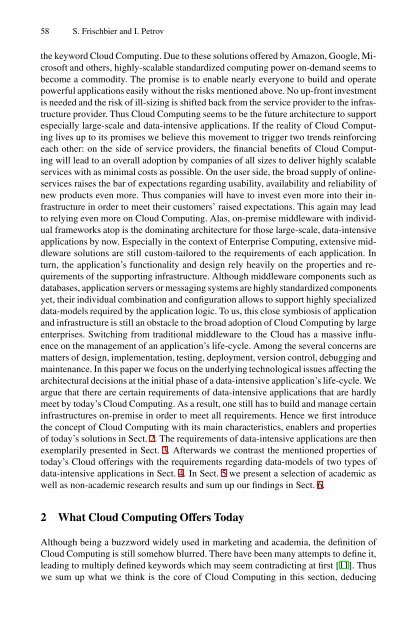Aspects of Data-Intensive Cloud Computing - DVS - Technische ...
Aspects of Data-Intensive Cloud Computing - DVS - Technische ...
Aspects of Data-Intensive Cloud Computing - DVS - Technische ...
You also want an ePaper? Increase the reach of your titles
YUMPU automatically turns print PDFs into web optimized ePapers that Google loves.
58 S. Frischbier and I. Petrov<br />
the keyword <strong>Cloud</strong> <strong>Computing</strong>. Due to these solutions <strong>of</strong>fered by Amazon, Google, Micros<strong>of</strong>t<br />
and others, highly-scalable standardized computing power on-demand seems to<br />
become a commodity. The promise is to enable nearly everyone to build and operate<br />
powerful applications easily without the risks mentioned above. No up-front investment<br />
is needed and the risk <strong>of</strong> ill-sizing is shifted back from the service provider to the infrastructure<br />
provider. Thus <strong>Cloud</strong> <strong>Computing</strong> seems to be the future architecture to support<br />
especially large-scale and data-intensive applications. If the reality <strong>of</strong> <strong>Cloud</strong> <strong>Computing</strong><br />
lives up to its promises we believe this movement to trigger two trends reinforcing<br />
each other: on the side <strong>of</strong> service providers, the financial benefits <strong>of</strong> <strong>Cloud</strong> <strong>Computing</strong><br />
will lead to an overall adoption by companies <strong>of</strong> all sizes to deliver highly scalable<br />
services with as minimal costs as possible. On the user side, the broad supply <strong>of</strong> onlineservices<br />
raises the bar <strong>of</strong> expectations regarding usability, availability and reliability <strong>of</strong><br />
new products even more. Thus companies will have to invest even more into their infrastructure<br />
in order to meet their customers’ raised expectations. This again may lead<br />
to relying even more on <strong>Cloud</strong> <strong>Computing</strong>. Alas, on-premise middleware with individual<br />
frameworks atop is the dominating architecture for those large-scale, data-intensive<br />
applications by now. Especially in the context <strong>of</strong> Enterprise <strong>Computing</strong>, extensive middleware<br />
solutions are still custom-tailored to the requirements <strong>of</strong> each application. In<br />
turn, the application’s functionality and design rely heavily on the properties and requirements<br />
<strong>of</strong> the supporting infrastructure. Although middleware components such as<br />
databases, application servers or messaging systems are highly standardized components<br />
yet, their individual combination and configuration allows to support highly specialized<br />
data-models required by the application logic. To us, this close symbiosis <strong>of</strong> application<br />
and infrastructure is still an obstacle to the broad adoption <strong>of</strong> <strong>Cloud</strong> <strong>Computing</strong> by large<br />
enterprises. Switching from traditional middleware to the <strong>Cloud</strong> has a massive influence<br />
on the management <strong>of</strong> an application’s life-cycle. Among the several concerns are<br />
matters <strong>of</strong> design, implementation, testing, deployment, version control, debugging and<br />
maintenance. In this paper we focus on the underlying technological issues affecting the<br />
architectural decisions at the initial phase <strong>of</strong> a data-intensive application’s life-cycle. We<br />
argue that there are certain requirements <strong>of</strong> data-intensive applications that are hardly<br />
meet by today’s <strong>Cloud</strong> <strong>Computing</strong>. As a result, one still has to build and manage certain<br />
infrastructures on-premise in order to meet all requirements. Hence we first introduce<br />
the concept <strong>of</strong> <strong>Cloud</strong> <strong>Computing</strong> with its main characteristics, enablers and properties<br />
<strong>of</strong> today’s solutions in Sect. 2. The requirements <strong>of</strong> data-intensive applications are then<br />
exemplarily presented in Sect. 3. Afterwards we contrast the mentioned properties <strong>of</strong><br />
today’s <strong>Cloud</strong> <strong>of</strong>ferings with the requirements regarding data-models <strong>of</strong> two types <strong>of</strong><br />
data-intensive applications in Sect. 4. In Sect. 5 we present a selection <strong>of</strong> academic as<br />
well as non-academic research results and sum up our findings in Sect. 6.<br />
2 What <strong>Cloud</strong> <strong>Computing</strong> Offers Today<br />
Although being a buzzword widely used in marketing and academia, the definition <strong>of</strong><br />
<strong>Cloud</strong> <strong>Computing</strong> is still somehow blurred. There have been many attempts to define it,<br />
leading to multiply defined keywords which may seem contradicting at first [11]. Thus<br />
we sum up what we think is the core <strong>of</strong> <strong>Cloud</strong> <strong>Computing</strong> in this section, deducing















